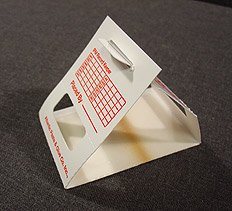
pest management
1 Preventing Pest Infestation | 2 Responding to Pest Infestation
|
|
1 Preventing Pest Infestation
Integrated pest management strategies are best practices in cultural heritage collections that focus on improving building and storage conditions to prevent insects from settling into an institution. Tactics include blocking routes for pests to enter the building (such as windows, vents, and cracks), maintaining a moderate climate, avoiding water leakage or standing water, removing or controlling food sources, and housekeeping practices like dusting, vacuuming, and garbage removal. Inspecting incoming collections for evidence of pests, as well as performing regular building inspections to look for signs of insect evidence like droppings or bodies, are long-term responsibilities to prevent against infestation.
The use of pesticides to prevent pests and respond to infestations has been common in cultural institutions, but preservation professionals now recommend a strategy called integrated pest management (IPM). IPM relies on non-chemical methods to prevent and manage pest infestation.
2 Responding to Pest Infestation
Monitoring
|
|
If a few insects are observed in the building, monitor the situation with sticky traps (available in hardware and grocery stores) to determine the type of insect(s), the number of insects, and their entry points. Place traps in consistent locations, number and date them, and inspect them routinely. Traps that are unchecked don't provide any useful data, and may become food sources for other pests if left undisturbed for long periods of time. If results are negative, relocate the traps. Once insects have been trapped, identify them to determine what threat they pose to collections.
In cases where there is a serious insect infestation that does not respond to preventive techniques, direct treatment for insect infestation may be necessary.
Non-chemical Treatments
Controlled freezing of infected collections, along with modified atmospheres have been used successfully to eradicate pests in cultural collections. Controlled freezing can be done in household or commercial freezers, blast freezers, or freezers with controlled temperature and humidity. Modified atmospheres (decreased oxygen, increased carbon dioxide, or use of an inert gas such as nitrogen) can be applied in a fumigation chamber or bubble, or in low-permeability plastic bags. Specific procedures must be followed for both methods; see the NEDCC Preservation Leaflet Integrated Pest Management for details.
Heat, gamma radiation, and microwaves are used for insect control in food processing and other industries, but are not recommended for cultural collections due to their damaging effects on collections.
Chemical Treatments
Current preservation practice does not recommend extermination (chemical treatments) for pest problems except as a last resort, due to the toxic nature of pesticides.


